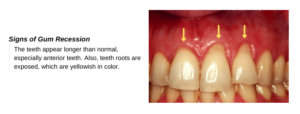
The most common form of gingival recession is the anterior crossbite, an anterior-posterior malocclusion associated with deviation of the eruption axis. This condition can be an esthetic and functional problem that can lead to gum recession. The mandible’s anterior region is thin, with a weakened buccal bone plate that makes it prone to receding gums. Furthermore, proclination of the mandibular incisors may also cause soft tissue injury.
Despite the widespread prevalence of this condition, the primary characteristic is apical migration of the marginal gingiva. The gingiva gradually recedes away from the cementoenamel junction, exposing the root surface. Although this condition can affect all populations of the world, it usually only affects one root surface. Therefore, it is important to know the underlying causes of this ailment before starting treatment.
While most cases of gingival recession are not classified by the Miller classification system, other methods have been developed to provide an accurate and comprehensive picture of this condition. The newer, comprehensive classification of the recession defect by Kumar & Masamatti overcomes these limitations and also differentiates between buccal, lingual, and palatal recessions. Further, this system is based on the position of the interdental papilla, and also on the location of the teeth.
The Miller’s classification system is the most common method for identifying gingival recession. However, there are many instances where a standard classification system is unable to accurately categorize the disease. To overcome these limitations, the latest comprehensive system developed by Kumar & Masamatti provides an accurate and detailed depiction of the recession defect. They distinguish between buccal and palatal recessions. This comprehensive classification is the most effective method of identifying the exact cause of gingival recession.
A diagnosis of gingival recession requires a dental examination. The recession can be caused by a variety of factors, including aging. A dentist may prescribe a periodontal therapy if the disease is progressing quickly. Additionally, a periodontist can perform a periodontal surgery to prevent the recession. This procedure is known as apical surgery. A dentist can detect the recession by taking X-rays and evaluating the depth of the roots.
Your dentist can help you prevent gum recession by taking preventative measures. Regular checkups are essential, and your dentist can help you prevent gum recession from progressing. If you think your recession is progressing quickly, your dentist may be able to intervene and refer you to a specialist. They will also be able to diagnose the disease. In such cases, a specialist may have to perform surgery to treat root cancer.
The causes of gum
recession are not fully understood. Typically, the disease is characterized by apical migration of the marginal gingiva. The gum gradually moves away from the cemento-enamel junction, exposing the tooth root surface to the oral environment. There is no specific treatment for this condition, but it may require treatment. In some cases, patients may face a combination of orthodontic measures and preventative treatment.
Besides genetics, many other genetic diseases and dental conditions can also lead to gum recession. People suffering from this condition are predisposed to poor oral hygiene, which is the main cause of this disease. Although this disease is not contagious, it can lead to tooth loss if left untreated. A pedodontist can prevent this disease by ensuring proper oral hygiene.
Although most of these conditions can be prevented with orthodontic treatment, the dentist can intervene. If gum recession progresses rapidly, your dentist may recommend regular visits to evaluate the condition. In some cases, gum recession is caused by an orthodontic discrepancy between the two sides of a tooth. The site Kopertis 4
recommends that the best treatment is to undergo corrective procedures and prevent further damage to the teeth and gums.
There are several causes of gum recession, which are influenced by several factors. In cases of gum recession, the most common cause is loss of bone support. Bone loss supports the gums, which can cause them to recede. This leads to apical migration of the gums. Apical migration is also associated with an increased risk of caries and aesthetic problems.
